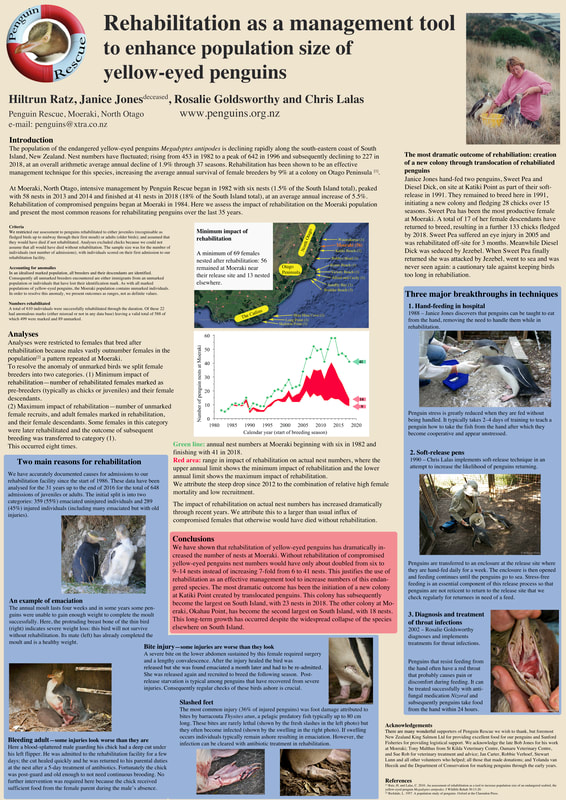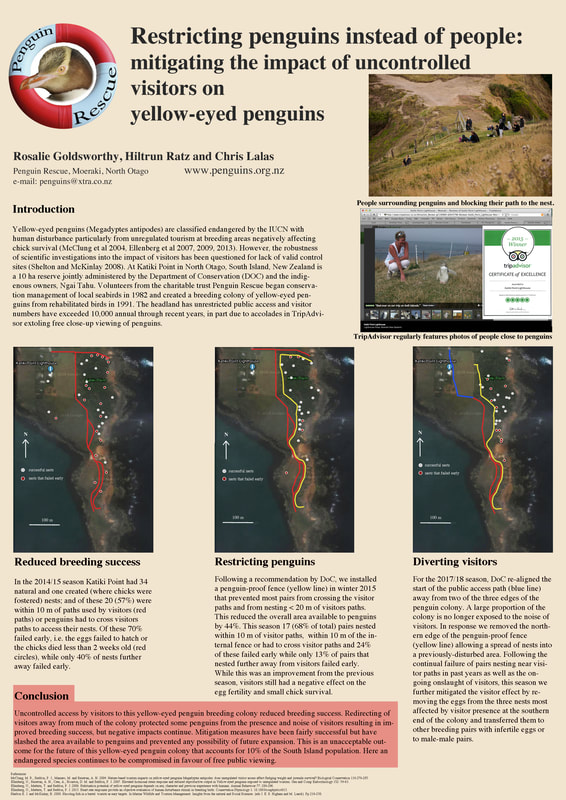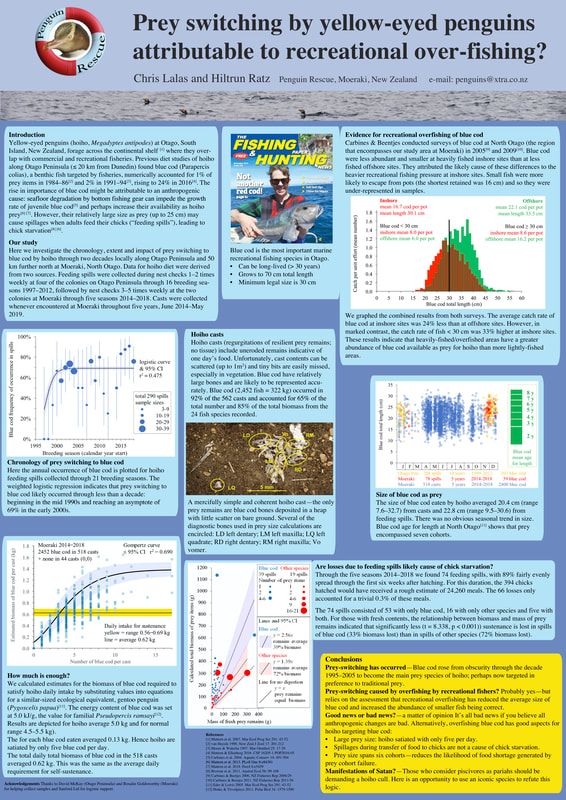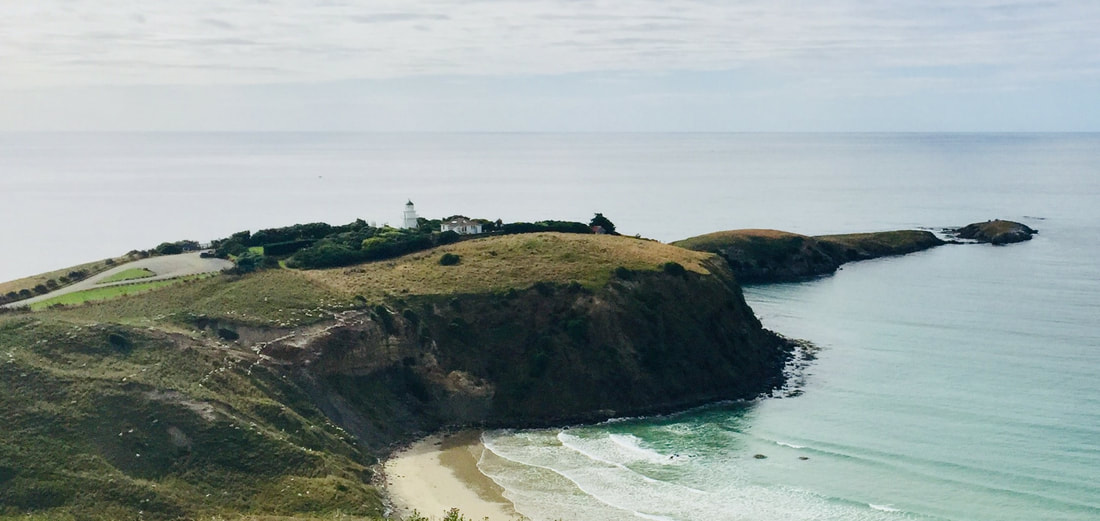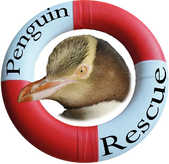Penguin Rescue science
The conservation effort in the penguin colonies at Moeraki is underscored by scientific work and supported by hands-on experience over decades by Dr Hiltrun Ratz and Dr Chris Lalas, scientists and trustees for Penguin Rescue. Here are scientific publications authored or co-authored by them.
For copyright reasons we are unable to post the full text of our papers but if you find it impossible to source them from elsewhere, please contact us and we can send you a pdf for your personal study.
10th International Penguin Conference, Dunedin, August 2019: poster
Ratz, H, Jones, J., Goldsworthy, R. and Lalas, C.
Rehabilitation as a management tool to enhance population size of yellow-eyed penguins
Ratz, H, Jones, J., Goldsworthy, R. and Lalas, C.
Rehabilitation as a management tool to enhance population size of yellow-eyed penguins
| |||||||
10th International Penguin Conference, Dunedin, August 2019: poster
Goldsworthy, R., Ratz, H., and Lalas, C.
Restricting penguins instead of people: mitigating the impact of uncontrolled visitors on yellow-eyed penguins.
Goldsworthy, R., Ratz, H., and Lalas, C.
Restricting penguins instead of people: mitigating the impact of uncontrolled visitors on yellow-eyed penguins.
| |||||||
10th International Penguin Conference, Dunedin, August 2019: poster
Lalas, C. and Ratz, H.
Prey switching in yellow-eyed penguins attributable to recreational over-fishing?
Lalas, C. and Ratz, H.
Prey switching in yellow-eyed penguins attributable to recreational over-fishing?
| |||||||
Grosser, S., Ratz, H. and Waters, J. M. 2015.
DNA samples from wild animal populations as a byproduct of PIT tagging. Conservation Genetics Resources DOI 10.1007/s12686-015-0463-1
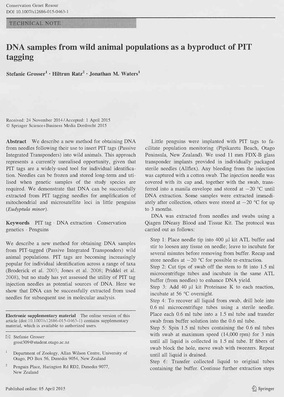
Abstract
We describe a new method for obtaining DNA from needles following their use to insert PIT tags (Passive Integrated Transponders) into wild animals. This approach represents a currently unrealised opportunity, given that PIT tags are widely-used tool for individual identification. Needles can be frozen and stored long-term and utilised when genetic samples of the study species are required. We demonstrate that DNA can be successfully extracted from PIT tagging needles for amplification of mitochondrial and microsatellite loci in little penguins (Eudyptula minor).
We describe a new method for obtaining DNA from needles following their use to insert PIT tags (Passive Integrated Transponders) into wild animals. This approach represents a currently unrealised opportunity, given that PIT tags are widely-used tool for individual identification. Needles can be frozen and stored long-term and utilised when genetic samples of the study species are required. We demonstrate that DNA can be successfully extracted from PIT tagging needles for amplification of mitochondrial and microsatellite loci in little penguins (Eudyptula minor).
Agnew, P, Houston, D., Lalas, C. and Wright, J. 2014.
Variation in reproductive performance of Little Penguins (Eudyptula minor) attributable to double brooding. Journal of Ornithology 155: 101-109.
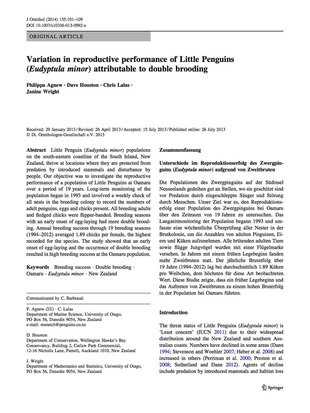
Abstract
Little Penguin (Eudyptula minor) populations on the south-eastern coastline of the South Island, New Zealand, thrive at locations where they are protected from predation by introduced mammals and disturbance by people. Our objective was to investigate the reproductive performance of a population of Little Penguins at Oamaru over a period of 19 years. Long-term monitoring of the population began in 1993 and involved a weekly check of all nests in the breeding colony to record the numbers of adult penguins, eggs and chicks present. All breeding adults and fledged chicks were flipper-banded. Breeding seasons with an early onset of egg-laying had more double brooding. Annual breeding success through 19 breeding seasons (1994–2012) averaged 1.89 chicks per female, the highest recorded for the species. The study showed that an early onset of egg-laying and the occurrence of double brooding resulted in high breeding success at the Oamaru population.
Little Penguin (Eudyptula minor) populations on the south-eastern coastline of the South Island, New Zealand, thrive at locations where they are protected from predation by introduced mammals and disturbance by people. Our objective was to investigate the reproductive performance of a population of Little Penguins at Oamaru over a period of 19 years. Long-term monitoring of the population began in 1993 and involved a weekly check of all nests in the breeding colony to record the numbers of adult penguins, eggs and chicks present. All breeding adults and fledged chicks were flipper-banded. Breeding seasons with an early onset of egg-laying had more double brooding. Annual breeding success through 19 breeding seasons (1994–2012) averaged 1.89 chicks per female, the highest recorded for the species. The study showed that an early onset of egg-laying and the occurrence of double brooding resulted in high breeding success at the Oamaru population.
Flemming, S. A., Lalas, C. and van Heezik, Y. 2013.
Little penguin (Eudyptula minor) diet at three breeding colonies in New Zealand. New Zealand Journal of Ecology 37: 199-205.
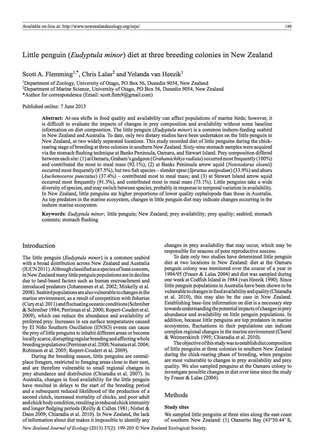
Abstract
At-sea shifts in food quality and availability can affect populations of marine birds; however, it is difficult to evaluate the impacts of changes in prey composition and availability without some baseline information on diet composition. The little penguin (Eudyptula minor) is a common inshore-feeding seabird in New Zealand and Australia. To date, only two dietary studies have been undertaken on the little penguin in New Zealand, at two widely separated locations. This study recorded diet of little penguins during the chick-rearing stage of breeding at three colonies in southern New Zealand. Sixty-nine stomach samples were acquired via the stomach flushing technique at Banks Peninsula, Oamaru, and Stewart Island. Prey composition differed between each site: (1) at Oamaru, Graham’s gudgeon (Grahamichthys radiata) occurred most frequently (100%) and contributed the most to meal mass (92.1%); (2) at Banks Peninsula arrow squid (Nototodarus sloanii) occurred most frequently (87.5%), but two fish species – slender sprat (Sprattus antipodum) (33.9%) and ahuru (Auchenoceros punctatus) (37.4%) – contributed most to meal mass; and (3) at Stewart Island arrow squid occurred most frequently (91.3%), and contributed most to meal mass (73.1%). Little penguins take a wide diversity of species, and may switch between species, probably in response to temporal variation in availability. In New Zealand, little penguins ate higher proportions of lower quality cephalopods than those in Australia. As top predators in the marine ecosystem, changes in little penguin diet may indicate changes occurring in the inshore marine ecosystem.
At-sea shifts in food quality and availability can affect populations of marine birds; however, it is difficult to evaluate the impacts of changes in prey composition and availability without some baseline information on diet composition. The little penguin (Eudyptula minor) is a common inshore-feeding seabird in New Zealand and Australia. To date, only two dietary studies have been undertaken on the little penguin in New Zealand, at two widely separated locations. This study recorded diet of little penguins during the chick-rearing stage of breeding at three colonies in southern New Zealand. Sixty-nine stomach samples were acquired via the stomach flushing technique at Banks Peninsula, Oamaru, and Stewart Island. Prey composition differed between each site: (1) at Oamaru, Graham’s gudgeon (Grahamichthys radiata) occurred most frequently (100%) and contributed the most to meal mass (92.1%); (2) at Banks Peninsula arrow squid (Nototodarus sloanii) occurred most frequently (87.5%), but two fish species – slender sprat (Sprattus antipodum) (33.9%) and ahuru (Auchenoceros punctatus) (37.4%) – contributed most to meal mass; and (3) at Stewart Island arrow squid occurred most frequently (91.3%), and contributed most to meal mass (73.1%). Little penguins take a wide diversity of species, and may switch between species, probably in response to temporal variation in availability. In New Zealand, little penguins ate higher proportions of lower quality cephalopods than those in Australia. As top predators in the marine ecosystem, changes in little penguin diet may indicate changes occurring in the inshore marine ecosystem.
Agnew, P., Lalas, C., Wright, J. and Dawson, S. 2013.
Effects of attached data-logging devices on little penguins (Eudyptula minor). Marine Biology 160: 2375-2382.
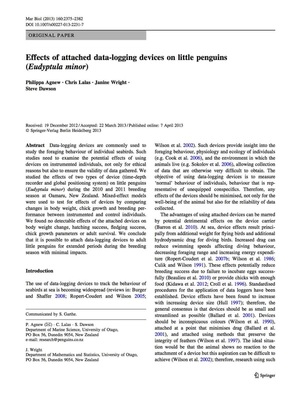
Abstract
Data-logging devices are commonly used to study the foraging behaviour of individual seabirds. Such studies need to examine the potential effects of using devices on instrumented individuals, not only for ethical reasons but also to ensure the validity of data gathered. We studied the effects of two types of device (time-depth recorder and global positioning system) on little penguins (Eudyptula minor) during the 2010 and 2011 breeding season at Oamaru, New Zealand. Mixed-effect models were used to test for effects of devices by comparing changes in body weight, chick growth and breeding performance between instrumented and control individuals. We found no detectable effects of the attached devices on body weight change, hatching success, fledging success, chick growth parameters or adult survival. We conclude that it is possible to attach data-logging devices to adult little penguins for extended periods during the breeding season with minimal impacts.
Data-logging devices are commonly used to study the foraging behaviour of individual seabirds. Such studies need to examine the potential effects of using devices on instrumented individuals, not only for ethical reasons but also to ensure the validity of data gathered. We studied the effects of two types of device (time-depth recorder and global positioning system) on little penguins (Eudyptula minor) during the 2010 and 2011 breeding season at Oamaru, New Zealand. Mixed-effect models were used to test for effects of devices by comparing changes in body weight, chick growth and breeding performance between instrumented and control individuals. We found no detectable effects of the attached devices on body weight change, hatching success, fledging success, chick growth parameters or adult survival. We conclude that it is possible to attach data-logging devices to adult little penguins for extended periods during the breeding season with minimal impacts.
Browne, T., Lalas, C., Mattern, T. and van Heezik, Y. 2011.
Chick starvation in yellow-eyed penguins: Evidence for poor diet quality and selective provisioning of chicks from conventional diet analysis and stable isotopes. Austral Ecology 36: 99-108.
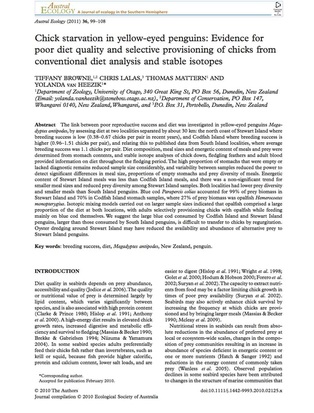
Abstract
The link between poor reproductive success and diet was investigated in yellow-eyed penguins Megadyptes antipodes, by assessing diet at two localities separated by about 30 km: the north coast of Stewart Island where breeding success is low (0.38–0.67 chicks per pair in recent years), and Codfish Island where breeding success is higher (0.96–1.51 chicks per pair), and relating this to published data from South Island localities, where average breeding success was 1.1 chicks per pair. Diet composition, meal sizes and energetic content of meals and prey were determined from stomach contents, and stable isotope analyses of chick down, fledgling feathers and adult blood provided information on diet throughout the fledging period. The high proportion of stomachs that were empty or lacked diagnostic remains reduced sample size considerably, and variability between samples reduced the power to detect significant differences in meal size, proportions of empty stomachs and prey diversity of meals. Energetic content of Stewart Island meals was less than Codfish Island meals, and there was a non-significant trend for smaller meal sizes and reduced prey diversity among Stewart Island samples. Both localities had lower prey diversity and smaller meals than South Island penguins. Blue cod Parapercis colias accounted for 99% of prey biomass in Stewart Island and 70% in Codfish Island stomach samples, where 27% of prey biomass was opalfish Hemerocoetes monopterygius. Isotopic mixing models carried out on larger sample sizes indicated that opalfish comprised a large proportion of the diet at both locations, with adults selectively provisioning chicks with opalfish while feeding mainly on blue cod themselves. We suggest the large blue cod consumed by Codfish Island and Stewart Island penguins, larger than those consumed by South Island penguins, is difficult to transfer to chicks by regurgitation. Oyster dredging around Stewart Island may have reduced the availability and abundance of alternative prey to Stewart Island penguins.
The link between poor reproductive success and diet was investigated in yellow-eyed penguins Megadyptes antipodes, by assessing diet at two localities separated by about 30 km: the north coast of Stewart Island where breeding success is low (0.38–0.67 chicks per pair in recent years), and Codfish Island where breeding success is higher (0.96–1.51 chicks per pair), and relating this to published data from South Island localities, where average breeding success was 1.1 chicks per pair. Diet composition, meal sizes and energetic content of meals and prey were determined from stomach contents, and stable isotope analyses of chick down, fledgling feathers and adult blood provided information on diet throughout the fledging period. The high proportion of stomachs that were empty or lacked diagnostic remains reduced sample size considerably, and variability between samples reduced the power to detect significant differences in meal size, proportions of empty stomachs and prey diversity of meals. Energetic content of Stewart Island meals was less than Codfish Island meals, and there was a non-significant trend for smaller meal sizes and reduced prey diversity among Stewart Island samples. Both localities had lower prey diversity and smaller meals than South Island penguins. Blue cod Parapercis colias accounted for 99% of prey biomass in Stewart Island and 70% in Codfish Island stomach samples, where 27% of prey biomass was opalfish Hemerocoetes monopterygius. Isotopic mixing models carried out on larger sample sizes indicated that opalfish comprised a large proportion of the diet at both locations, with adults selectively provisioning chicks with opalfish while feeding mainly on blue cod themselves. We suggest the large blue cod consumed by Codfish Island and Stewart Island penguins, larger than those consumed by South Island penguins, is difficult to transfer to chicks by regurgitation. Oyster dredging around Stewart Island may have reduced the availability and abundance of alternative prey to Stewart Island penguins.
Ratz, H. and Lalas, C. 2010.
An assessment of rehabilitation as a toll to increase population size of an endangered seabird, the Yellow-eyed penguin (Megadyptes antipodes). Journal of Wildlife Rehabilitation 30: 13-20.
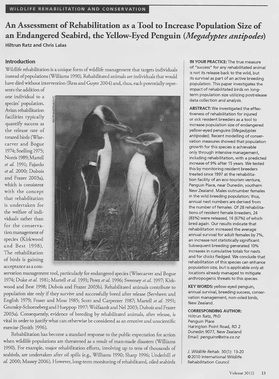
Abstract
We investigated the effectiveness of rehabilitation for injured or sick resident breeders as a tool to increase population size of endangered yellow-eyed penguins (Megadyptes antipodes). Recent modeling of conservation measures showed that population growth for this species is achievable only through intensive management including rehabilitation, with a predicted increase of 9% after 15 years. We tested this by monitoring resident breeders treated since 1997 at the rehabilitation facility of an eco-tourism ventures, Penguin Place, near Dunedin, southern New Zealand. Males outnumber females in the wild breeding population; thus, annual nest numbers are derived from the number females. Of 28 rehabilitations of resident female breeders, 24 (83%) were released, 16 (67%) of which bred again. Our results indicate that rehabilitation increases the average annual survival for adult females by 7%, an increase not statistically significant. Subsequent breeding generated 10% increases in cumulative totals for nest and for chicks fledged. We conclude that rehabilitation of this species can enhance population size, but is applicable only at locations already managed to mitigate anthropogenic threats to this species.
We investigated the effectiveness of rehabilitation for injured or sick resident breeders as a tool to increase population size of endangered yellow-eyed penguins (Megadyptes antipodes). Recent modeling of conservation measures showed that population growth for this species is achievable only through intensive management including rehabilitation, with a predicted increase of 9% after 15 years. We tested this by monitoring resident breeders treated since 1997 at the rehabilitation facility of an eco-tourism ventures, Penguin Place, near Dunedin, southern New Zealand. Males outnumber females in the wild breeding population; thus, annual nest numbers are derived from the number females. Of 28 rehabilitations of resident female breeders, 24 (83%) were released, 16 (67%) of which bred again. Our results indicate that rehabilitation increases the average annual survival for adult females by 7%, an increase not statistically significant. Subsequent breeding generated 10% increases in cumulative totals for nest and for chicks fledged. We conclude that rehabilitation of this species can enhance population size, but is applicable only at locations already managed to mitigate anthropogenic threats to this species.
Mattern, T., Houston, D. M., Lalas, C., Setiawan, A. N. and Davis, L. S. 2009.
Diet composition, continuity in prey availability and marine habitat - keystones to population stability in the Snares Penguin (Eudyptes robustus). Emu 109: 204-213.
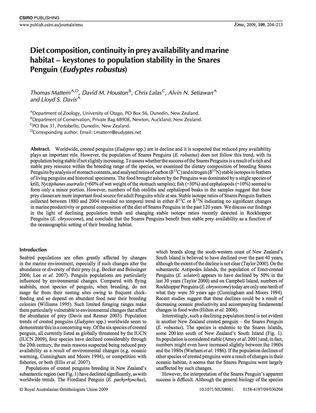
Abstract
Worldwide, crested penguins (Eudyptes spp.) are in decline and it is suspected that reduced prey availability plays an important role. However, the population of Snares Penguins (E. robustus) does not follow this trend, with its population being stable if not slightly increasing. To assess whether the success of the Snares Penguins is a result of a rich and stable prey resource within the breeding range of the species, we examined the dietary composition of breeding Snares Penguins by analysis of stomach contents, and analysed ratios of carbon (13C) and nitrogen (15N) stable isotopes in feathers of living penguins and historical specimens. The food brought ashore by the Penguins was dominated by a single species of krill, Nyctiphanes australis (~60% of wet weight of the stomach samples); fish (~30%) and cephalopods (~10%) seemed to form only a minor portion. However, numbers of fish otoliths and cephalopod beaks in the samples suggest that these prey classes are more important food source for adult Penguins while at sea. Stable isotope ratios of Snares Penguin feathers collected between 1880 and 2004 revealed no temporal trend in either 13C or 15N indicating no significant changes in marine productivity or general composition of the diet of Snares Penguins in the past 120 years. We discuss our findings in the light of declining population trends and changing stable isotope ratios recently detected in Rockhopper Penguins (E. chrysocome), and conclude that the Snares Penguins benefit from stable prey availability as a function of the oceanographic setting of their breeding habitat.
Worldwide, crested penguins (Eudyptes spp.) are in decline and it is suspected that reduced prey availability plays an important role. However, the population of Snares Penguins (E. robustus) does not follow this trend, with its population being stable if not slightly increasing. To assess whether the success of the Snares Penguins is a result of a rich and stable prey resource within the breeding range of the species, we examined the dietary composition of breeding Snares Penguins by analysis of stomach contents, and analysed ratios of carbon (13C) and nitrogen (15N) stable isotopes in feathers of living penguins and historical specimens. The food brought ashore by the Penguins was dominated by a single species of krill, Nyctiphanes australis (~60% of wet weight of the stomach samples); fish (~30%) and cephalopods (~10%) seemed to form only a minor portion. However, numbers of fish otoliths and cephalopod beaks in the samples suggest that these prey classes are more important food source for adult Penguins while at sea. Stable isotope ratios of Snares Penguin feathers collected between 1880 and 2004 revealed no temporal trend in either 13C or 15N indicating no significant changes in marine productivity or general composition of the diet of Snares Penguins in the past 120 years. We discuss our findings in the light of declining population trends and changing stable isotope ratios recently detected in Rockhopper Penguins (E. chrysocome), and conclude that the Snares Penguins benefit from stable prey availability as a function of the oceanographic setting of their breeding habitat.
Lalas, C., Ratz, H., McEwan, K. and McConkey, S. D. 2007.
Predation by New Zealand sea lions (Phocarctos hookeri) as a threat to the viability of yellow-eyed penguins (Megadyptes antipodes) at Otago Peninsula, New Zealand. Biological Conservation 135: 235-246.
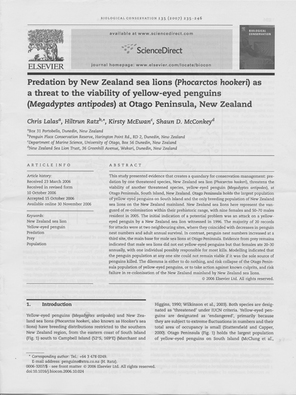
Abstract
This study presented evidence that creates a quandary for conservation management: predation by one threatened species, the New Zealand sea lion (Phocarctos hookeri), threatens the viability of another threatened species, yellow-eyed penguin (Megadyptes antipodes), at Otago Peninsula, South Island, New Zealand. Otago Peninsula holds the largest population of yellow-eyed penguins on South Island and the only breeding population of New Zealand sea lions on the New Zealand mainland. New Zealand sea lions here represent the vanguard of re-colonisation within their prehistoric range, with nine females and 50-70 males resident in 2005. The initial indication of a potential problem was an attack on a yellow-eyed penguin by a New Zealand sea lion witnessed in 1996. the majority of 20 records for attacks were at two neighbouring sites, where they coincided with decreases in penguin nest numbers and adult annual survival. In contrast, penguin numbers increased at a third site, the main base for male sea lions at Otago Peninsula. Evidence from prey remains indicated that male sea lions did not eat yellow-eyed penguins but that females ate 20-30 annually, with one individual possibly responsible for most kills. Modelling indicated that the penguin population at one site could not remain viable if it was the sole source of penguin killed. The dilemma is either to do nothing, and risk the collapse of the Otago Peninsula population of yellow-eyed penguins, or to take action against known culprits, and risk failure in re-colonisation of the New Zealand mainland by New Zealand sea lions.
This study presented evidence that creates a quandary for conservation management: predation by one threatened species, the New Zealand sea lion (Phocarctos hookeri), threatens the viability of another threatened species, yellow-eyed penguin (Megadyptes antipodes), at Otago Peninsula, South Island, New Zealand. Otago Peninsula holds the largest population of yellow-eyed penguins on South Island and the only breeding population of New Zealand sea lions on the New Zealand mainland. New Zealand sea lions here represent the vanguard of re-colonisation within their prehistoric range, with nine females and 50-70 males resident in 2005. The initial indication of a potential problem was an attack on a yellow-eyed penguin by a New Zealand sea lion witnessed in 1996. the majority of 20 records for attacks were at two neighbouring sites, where they coincided with decreases in penguin nest numbers and adult annual survival. In contrast, penguin numbers increased at a third site, the main base for male sea lions at Otago Peninsula. Evidence from prey remains indicated that male sea lions did not eat yellow-eyed penguins but that females ate 20-30 annually, with one individual possibly responsible for most kills. Modelling indicated that the penguin population at one site could not remain viable if it was the sole source of penguin killed. The dilemma is either to do nothing, and risk the collapse of the Otago Peninsula population of yellow-eyed penguins, or to take action against known culprits, and risk failure in re-colonisation of the New Zealand mainland by New Zealand sea lions.
Ratz, H., Darby, J. T., Edge, K.-A., and Thompson, C. 2004.
Survival and breeding of yellow-eyed penguins (Megadyptes antipodes), at two locations on Otago Peninsula, South Island, New Zealand, 1991-96. New Zealand Journal of Zoology 31: 133-147.
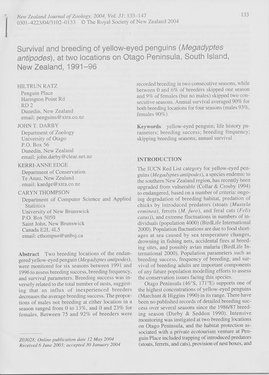
Abstract
Two breeding locations of the endangered yellow-eyed penguin (Megadyptes antipodes), were monitored for six seasons between 1991 and 1996 to assess breeding success, breeding frequency, and survival parameters. Breeding success was inversely related to the total number of nests, suggesting that an influx of inexperienced breeders decreases the average breeding success. The proportion of males not breeding at either location in a season ranged from 0 to 13%, and 0 and 23% for females. Between 75 and 92% of breeders were recorded breeding in two consecutive seasons, while between 0 and 6% of breeders skipped one season and 9% of females (but no males) skipped two consecutive seasons. Annual survival averaged 90% of both breeding locations for four seasons (males 93%, females 90%).
Two breeding locations of the endangered yellow-eyed penguin (Megadyptes antipodes), were monitored for six seasons between 1991 and 1996 to assess breeding success, breeding frequency, and survival parameters. Breeding success was inversely related to the total number of nests, suggesting that an influx of inexperienced breeders decreases the average breeding success. The proportion of males not breeding at either location in a season ranged from 0 to 13%, and 0 and 23% for females. Between 75 and 92% of breeders were recorded breeding in two consecutive seasons, while between 0 and 6% of breeders skipped one season and 9% of females (but no males) skipped two consecutive seasons. Annual survival averaged 90% of both breeding locations for four seasons (males 93%, females 90%).
Fraser, M. M. and Lalas, C. 2004.
Seasonal variation in the diet of blue penguins (Eudyptula minor) at Oamaru, New Zealand. Notornis 51: 7-15.
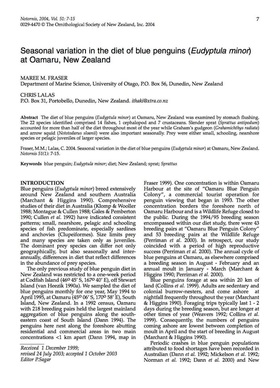
Abstract
The diet of blue penguins (Eudyptula minor) at Oamaru, New Zealand was examined by stomach flushing. The 22 species identified comprised 14 fishes, 1 cephalopod and 7 crustaceans. Slender sprat (Sprattus antipodum) accounted for more than half of the diet throughout most of the year while Graham’s gudgeon (Grahamichthys radiata) and arrow squid (Nototodarus sloanii) were also important seasonally. Prey were either small, schooling, nearshore species or pelagic juveniles of larger species.
The diet of blue penguins (Eudyptula minor) at Oamaru, New Zealand was examined by stomach flushing. The 22 species identified comprised 14 fishes, 1 cephalopod and 7 crustaceans. Slender sprat (Sprattus antipodum) accounted for more than half of the diet throughout most of the year while Graham’s gudgeon (Grahamichthys radiata) and arrow squid (Nototodarus sloanii) were also important seasonally. Prey were either small, schooling, nearshore species or pelagic juveniles of larger species.
Ratz, H. 2000.
Movements by stoats (Mustela erminea) and ferrets (M. furo) through rank grass of yellow-eyed penguin (Megadyptes antipodes) breeding areas. New Zealand Journal of Zoology 27: 57-69.
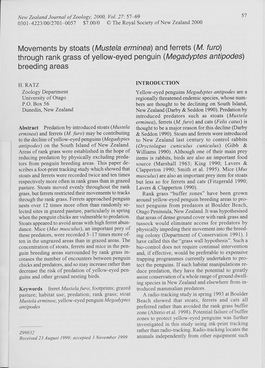
Abstract
Predation by introduced stoats (Mustela erminea) and ferrest (M. furo) may be contributing to the decline of yellow-eyed penguins (Megadyptes antipodes) on the South Island of New Zealand. Areas of rank grass were established in the hope of reducing predation by physically excluding predators from penguin breeding areas. This paper describes a foot-print tracking study which showed that stoats and ferrets were recorded twice and ten times respectively more often in rank grass than in grazed pasture. Stoats moved evenly throughout the rank grass, but ferrets restricted their movements to tracks through the rank grass. Ferrets approached penguin nests over 12 times more often than randomly selected sites in grazed pastures, particularly in spring when the penguin chicks are vulnerable to predation. Stoats appeared to avoid areas with high ferret abundance. Mice (Mus musculus), an important prey of these predators, were recorded 5-17 times more often in the ungrazed areas than in grazed areas. The concentration of stoats, ferrets and mice in the penguin breeding areas surrounded by rank grass increases the number on encounters between penguin chicks and predators, and so may increase rather than decrease the risk of predation of yellow-eyed penguins and other ground nesting birds.
Predation by introduced stoats (Mustela erminea) and ferrest (M. furo) may be contributing to the decline of yellow-eyed penguins (Megadyptes antipodes) on the South Island of New Zealand. Areas of rank grass were established in the hope of reducing predation by physically excluding predators from penguin breeding areas. This paper describes a foot-print tracking study which showed that stoats and ferrets were recorded twice and ten times respectively more often in rank grass than in grazed pasture. Stoats moved evenly throughout the rank grass, but ferrets restricted their movements to tracks through the rank grass. Ferrets approached penguin nests over 12 times more often than randomly selected sites in grazed pastures, particularly in spring when the penguin chicks are vulnerable to predation. Stoats appeared to avoid areas with high ferret abundance. Mice (Mus musculus), an important prey of these predators, were recorded 5-17 times more often in the ungrazed areas than in grazed areas. The concentration of stoats, ferrets and mice in the penguin breeding areas surrounded by rank grass increases the number on encounters between penguin chicks and predators, and so may increase rather than decrease the risk of predation of yellow-eyed penguins and other ground nesting birds.
Ratz, H. and Thompson, C. 1999.
Who is watching whom? Checks for impacts of tourists on yellow-eyed penguins Megadyptes antipodes. Marine Ornithology 27: 205-210.
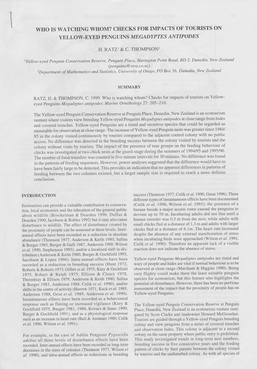
Abstract
The Yellow-eyed penguin Conservation Reserve at Penguin Place, Dunedin, New Zealand is an ecotourism venture where visitors view breeding Yellow-eyed Penguins Megadyptes antipodes at close range from hides and covered trenches. Yellow-eyed Penguins are timid and secretive species that could be regarded as unsuitable for observation at close range. The increase of Yellow-eyed penguin nests was greater since 1984/85 in the colony visited continuously by tourists compared to the adjacent control colony with no public access. No difference was detected in the breeding success between the colony visited by tourists, and the colony without visits by tourists. The impact of the presence of tour groups on the feeding behaviour of chicks was investigated at two-chick nests at the guard-stage during the summers of 1994/95 and 1995/96. The number of food transfers was counted in five-minute intervals for 30 minutes. No difference was found in the patterns of feeding sequences. However. Power analysis suggested that the difference would have to have been fairly large to be detected. This provides an indication that no apparent difference in patterns of feeding between the two colonies existed, but a large sample size is required to reach a more definite conclusion.
The Yellow-eyed penguin Conservation Reserve at Penguin Place, Dunedin, New Zealand is an ecotourism venture where visitors view breeding Yellow-eyed Penguins Megadyptes antipodes at close range from hides and covered trenches. Yellow-eyed Penguins are timid and secretive species that could be regarded as unsuitable for observation at close range. The increase of Yellow-eyed penguin nests was greater since 1984/85 in the colony visited continuously by tourists compared to the adjacent control colony with no public access. No difference was detected in the breeding success between the colony visited by tourists, and the colony without visits by tourists. The impact of the presence of tour groups on the feeding behaviour of chicks was investigated at two-chick nests at the guard-stage during the summers of 1994/95 and 1995/96. The number of food transfers was counted in five-minute intervals for 30 minutes. No difference was found in the patterns of feeding sequences. However. Power analysis suggested that the difference would have to have been fairly large to be detected. This provides an indication that no apparent difference in patterns of feeding between the two colonies existed, but a large sample size is required to reach a more definite conclusion.
McKay, R., Lalas, C., McKay, D. and McConkey, S. 1999.
Nest-site selection by yellow-eyed penguins Megadyptes antipodes on grazed farmland. Marine Ornithology 27: 29-35.
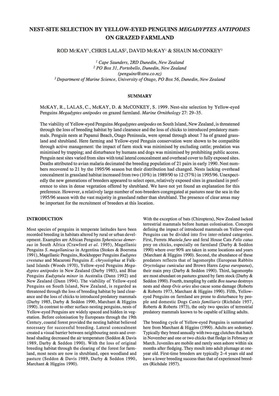
Abstract
The viability of Yellow-eyed Penguins Megadyptes antipodes on South Island, New Zealand, is threatened through the loss of breeding habitat by land clearance and the loss of chicks to introduced predatory mammals. Penguin nests at Papanui Beach, Otago Peninsula, were spread through about 7 ha of grazed grassland and shrubland. Here farming and Yellow-eyed Penguin conservation were shown to be compatible through active management: the impact of farm stock was minimised by excluding cattle; predation was minimised by trapping; and disturbance by humans and dogs was minimised by prohibiting public access. Penguin nest sites varied from sites with total lateral concealment and overhead cover to fully exposed sites. Deaths attributed to avian malaria decimated the breeding population of 21 pairs in early 1990. Nest numbers recovered to 21 by the 1995/96 season but their distribution had changed. Nests lacking overhead concealment in grassland habitat increased from two (10%) in 1989/90 to 12 (57%) in 1995/96. Unexpectedly the new generations of breeders appeared to select open, relatively exposed sites in grassland in preference to sites in dense vegetation offered by shrubland. We have not yet found an explanation for this preference. However, a relatively large number of non-breeders congregated at pastures near the sea in the 1995/96 season with the vast majority in grassland rather than shrubland. The presence of clear areas may be important for the recruitment of breeders at this location.
The viability of Yellow-eyed Penguins Megadyptes antipodes on South Island, New Zealand, is threatened through the loss of breeding habitat by land clearance and the loss of chicks to introduced predatory mammals. Penguin nests at Papanui Beach, Otago Peninsula, were spread through about 7 ha of grazed grassland and shrubland. Here farming and Yellow-eyed Penguin conservation were shown to be compatible through active management: the impact of farm stock was minimised by excluding cattle; predation was minimised by trapping; and disturbance by humans and dogs was minimised by prohibiting public access. Penguin nest sites varied from sites with total lateral concealment and overhead cover to fully exposed sites. Deaths attributed to avian malaria decimated the breeding population of 21 pairs in early 1990. Nest numbers recovered to 21 by the 1995/96 season but their distribution had changed. Nests lacking overhead concealment in grassland habitat increased from two (10%) in 1989/90 to 12 (57%) in 1995/96. Unexpectedly the new generations of breeders appeared to select open, relatively exposed sites in grassland in preference to sites in dense vegetation offered by shrubland. We have not yet found an explanation for this preference. However, a relatively large number of non-breeders congregated at pastures near the sea in the 1995/96 season with the vast majority in grassland rather than shrubland. The presence of clear areas may be important for the recruitment of breeders at this location.
Lalas, C., Jones, P. R. and Jones, J. 1999.
The design and use of a nest box for yellow-eyed penguins Megadyptes antipodes - a response to a conservation need. Marine Ornithology 27: 199-204.
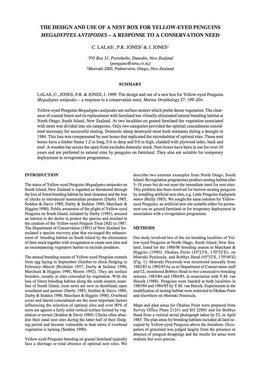
Abstract
Yellow-eyed Penguins Megadyptes antipodes are surface nesters which prefer dense vegetation. The clearance of coastal forest and its replacement with farmland has virtually eliminated natural breeding habitat at North Otago, South Island, New Zealand. At two localities on grazed farmland the vegetation associated with nests was divided into six categories. Only two categories provided the optimal concealment considered necessary for successful nesting. Domestic sheep destroyed most bush remnants during a drought in 1984. This loss was compensated by nest boxes that replicated the microhabitat of optimal sites. These nest boxes have a timber frame 1.2 m long, 0.6 m deep and 0.6 m high, cladded with plywood sides, back and roof. A wooden bar across the open front excludes domestic stock. Nest boxes have been in use for over 10 years and are preferred to natural sites by penguins on farmland. They also are suitable for temporary deployment in revegetation programmes.
Yellow-eyed Penguins Megadyptes antipodes are surface nesters which prefer dense vegetation. The clearance of coastal forest and its replacement with farmland has virtually eliminated natural breeding habitat at North Otago, South Island, New Zealand. At two localities on grazed farmland the vegetation associated with nests was divided into six categories. Only two categories provided the optimal concealment considered necessary for successful nesting. Domestic sheep destroyed most bush remnants during a drought in 1984. This loss was compensated by nest boxes that replicated the microhabitat of optimal sites. These nest boxes have a timber frame 1.2 m long, 0.6 m deep and 0.6 m high, cladded with plywood sides, back and roof. A wooden bar across the open front excludes domestic stock. Nest boxes have been in use for over 10 years and are preferred to natural sites by penguins on farmland. They also are suitable for temporary deployment in revegetation programmes.
Ratz, H. and Murphy, B. 1999.
Effects of habitat and introduced mammalian predators on the breeding success of Yellow-eyed Penguins Megadyptes antipodes, South Island, New Zealand. Pacific Conservation 5: 16-27.
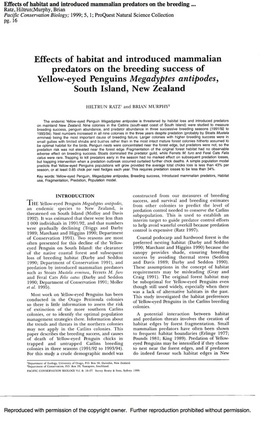
Abstract
The endemic Yellow-eyed Penguin Megadyptes antipodes is threatened by habitat loss and introduced predators on mainland New Zealand. Nine colonies in the Catlins (south-east coast of South Island) were studied to measure breeding success, penguin abundance, and predator abundance in three successive breeding seasons (1991/92 to 1993/94). Nest numbers increased in all nine colonies in the three years despite predation (probably by Stoats Mustela erminea) being the most important cause of breeding failure. Larger colonies with higher breeding success were in small gullies with limited shrubs and bushes rather than in the most intact mature forest colonies hitherto assumed to be optimal habitat for the birds. Penguin nests were concentrated near the forest edge, but predators were not, so the predation risk was not elevated near the forest edge. Fragmentation of the original forest habitat has no observable adverse effect on breeding success. Stoats dominated the predator guild, while Ferrets M. furo and Feral Cats Felis catus were rare. Trapping to kill predators early in the season had no marked effect on subsequent predation losses but trapping intervention when a predation outbreak occurred curtailed further chick deaths. A simple population model predicts that Yellow-eyed Penguin populations will grow provided the average total chick loss is less than 43% per season, or at least 0.85 chick per nest fledges each year. This requires predation losses to be less than 34%.
The endemic Yellow-eyed Penguin Megadyptes antipodes is threatened by habitat loss and introduced predators on mainland New Zealand. Nine colonies in the Catlins (south-east coast of South Island) were studied to measure breeding success, penguin abundance, and predator abundance in three successive breeding seasons (1991/92 to 1993/94). Nest numbers increased in all nine colonies in the three years despite predation (probably by Stoats Mustela erminea) being the most important cause of breeding failure. Larger colonies with higher breeding success were in small gullies with limited shrubs and bushes rather than in the most intact mature forest colonies hitherto assumed to be optimal habitat for the birds. Penguin nests were concentrated near the forest edge, but predators were not, so the predation risk was not elevated near the forest edge. Fragmentation of the original forest habitat has no observable adverse effect on breeding success. Stoats dominated the predator guild, while Ferrets M. furo and Feral Cats Felis catus were rare. Trapping to kill predators early in the season had no marked effect on subsequent predation losses but trapping intervention when a predation outbreak occurred curtailed further chick deaths. A simple population model predicts that Yellow-eyed Penguin populations will grow provided the average total chick loss is less than 43% per season, or at least 0.85 chick per nest fledges each year. This requires predation losses to be less than 34%.
Ratz, H., Moller, H. and Fletcher, D. 1999.
Predator identification from bite marks on penguin and albatross chicks. Marine Ornithology 27: 149-156.
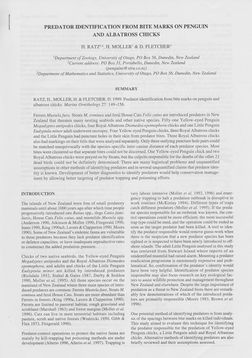
Abstract
Ferrets Mustela furo, Stoats M. erminea and feral House Cats Felis catus are introduced predators in New Zealand that threaten many nesting seabirds and other native species. Fifty-one Yellow-eyed Penguin Megadyptes antipodes chicks, four Royal Albatross Diomedea epomophora chicks and one Little Penguin Eudyptula minor adult underwent necropsy. Four Yellow-eyed Penguin chicks, three Royal Albatross chicks and the Little Penguin had puncture wounds in their skin from predator bites. Three Royal Albatross chicks also had markings on their bills that were analysed separately. Only three outlying puncture hole pairs could be matched unequivocally with the species-specific inter-canine distance of each predator species. Most bites were clustered so that separate bites could not be discerned. One Yellow-eyed penguin chick and two Royal Albatross chicks were preyed on by Stoats, but the culprits responsible for the deaths of the other 21 dead birds could not be definitely determined. There are many logistical problems and unquantified assumptions in other methods of identifying predators and in several unquantified claims that predator identity is known. Development of better diagnostics to identify predators would help conservation management by allowing better targeting of predator trapping and poisoning efforts.
Ferrets Mustela furo, Stoats M. erminea and feral House Cats Felis catus are introduced predators in New Zealand that threaten many nesting seabirds and other native species. Fifty-one Yellow-eyed Penguin Megadyptes antipodes chicks, four Royal Albatross Diomedea epomophora chicks and one Little Penguin Eudyptula minor adult underwent necropsy. Four Yellow-eyed Penguin chicks, three Royal Albatross chicks and the Little Penguin had puncture wounds in their skin from predator bites. Three Royal Albatross chicks also had markings on their bills that were analysed separately. Only three outlying puncture hole pairs could be matched unequivocally with the species-specific inter-canine distance of each predator species. Most bites were clustered so that separate bites could not be discerned. One Yellow-eyed penguin chick and two Royal Albatross chicks were preyed on by Stoats, but the culprits responsible for the deaths of the other 21 dead birds could not be definitely determined. There are many logistical problems and unquantified assumptions in other methods of identifying predators and in several unquantified claims that predator identity is known. Development of better diagnostics to identify predators would help conservation management by allowing better targeting of predator trapping and poisoning efforts.
Alterio, N., Moller, H. and Ratz, H. 1998
Movements and habitat use of feral house cats Felis catus, stoats Mustela erminea and ferrets M. furo, in grassland surrounding yellow-eyed penguin Megadyptes antipodes breeding areas in spring. Biological Conservation 83: 187-194.
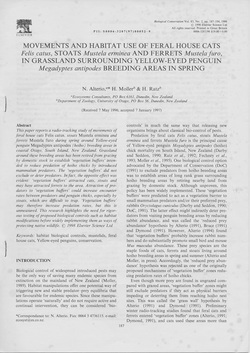
Abstract
This paper report a radio-tracking study of movements of feral house cats Felis catus, stoats Mustela erminea and ferrets Mustela furo during spring around Yellow-eyed penguin Megadyptes antipodes (hoiho) breeding areas in coastal Otago, South Island, New Zealand. Grassland around these breeding areas has been retired from grazing by domestic stock to establish 'vegetation buffers' intended to reduce predation of hoiho chicks by introduced mammalian predators. The 'vegetation buffers' did not exclude or deter predators. In fact, the opposite effect was evident: 'vegetation buffers' could increase encounter rates between predators and penguin chicks, especially by stoats, which are difficult to trap. 'Vegetation buffers' may therefore increase predation rates, but this is unmeasured. This research highlights the need for rigorous testing of proposed biological controls such as habitat modification before widely implementing them as ways of protecting native wildlife.
This paper report a radio-tracking study of movements of feral house cats Felis catus, stoats Mustela erminea and ferrets Mustela furo during spring around Yellow-eyed penguin Megadyptes antipodes (hoiho) breeding areas in coastal Otago, South Island, New Zealand. Grassland around these breeding areas has been retired from grazing by domestic stock to establish 'vegetation buffers' intended to reduce predation of hoiho chicks by introduced mammalian predators. The 'vegetation buffers' did not exclude or deter predators. In fact, the opposite effect was evident: 'vegetation buffers' could increase encounter rates between predators and penguin chicks, especially by stoats, which are difficult to trap. 'Vegetation buffers' may therefore increase predation rates, but this is unmeasured. This research highlights the need for rigorous testing of proposed biological controls such as habitat modification before widely implementing them as ways of protecting native wildlife.
Moller, H., Keedwell, R., Ratz, H. and Bruce, L. 1998
Lagomorph abundance around Yellow-eyed penguin (Megadyptes antipodes) colonies, South Island, New Zealand. New Zealand Journal of Ecology 22: 65-70.
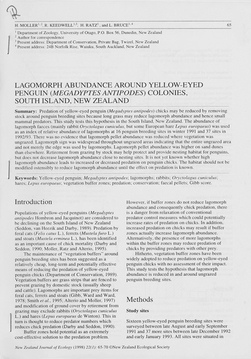
Abstract
Predation of yellow-eyed penguin (Megadyptes antipodes) chicks may be reduced by removing stock around penguin breeding sites because long grass may reduce lagomorph abundance and hence small mammal predators. This study test this hypothesis in the South Island, New Zealand. The abundance of lagomorph faeces (mainly rabbit Oryctolagus cuniculus but some European hare Lepus europaeus) was used as an index of relative abundance of lagomorphs at 16 penguin breeding sites in winter 1991 and 37 sites in 1992/93. There was no evidence that lagomorph pellet abundance was reduced where vegetation was ungrazed. Lagomorph sign was widespread throughout ungrazed areas indicating that the entire ungrazed area and not merely the edge was used by lagomporphs. Lagomorph pellet abundance was higher on sand dunes than elsewhere. Retirement from grazing by stock may help protect and provide nesting habitat for penguins, but does not decrease lagomorph abundance close to nesting sites. It is not yet known whether high lagomorph abundance leads to increase or decreased predation on penguin chicks. The habitat should not be modified ostensibly to reduce lagomorph abundance until the effect on predation is known.
Predation of yellow-eyed penguin (Megadyptes antipodes) chicks may be reduced by removing stock around penguin breeding sites because long grass may reduce lagomorph abundance and hence small mammal predators. This study test this hypothesis in the South Island, New Zealand. The abundance of lagomorph faeces (mainly rabbit Oryctolagus cuniculus but some European hare Lepus europaeus) was used as an index of relative abundance of lagomorphs at 16 penguin breeding sites in winter 1991 and 37 sites in 1992/93. There was no evidence that lagomorph pellet abundance was reduced where vegetation was ungrazed. Lagomorph sign was widespread throughout ungrazed areas indicating that the entire ungrazed area and not merely the edge was used by lagomporphs. Lagomorph pellet abundance was higher on sand dunes than elsewhere. Retirement from grazing by stock may help protect and provide nesting habitat for penguins, but does not decrease lagomorph abundance close to nesting sites. It is not yet known whether high lagomorph abundance leads to increase or decreased predation on penguin chicks. The habitat should not be modified ostensibly to reduce lagomorph abundance until the effect on predation is known.
